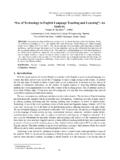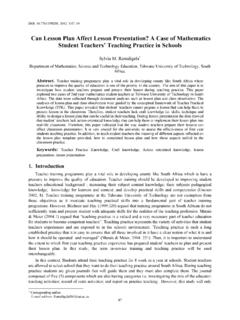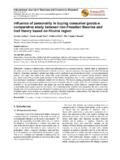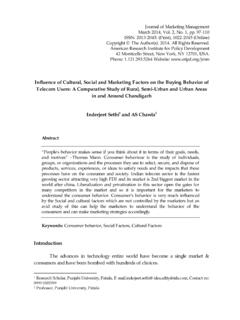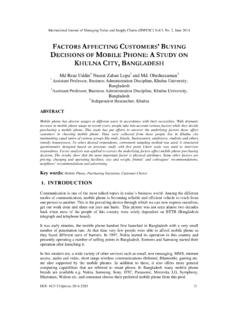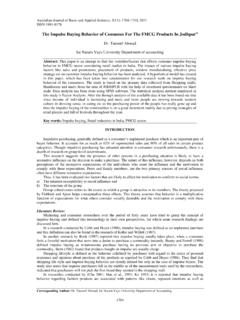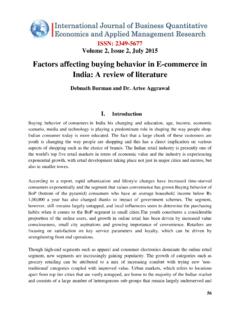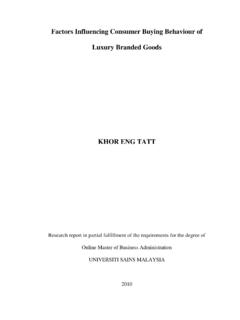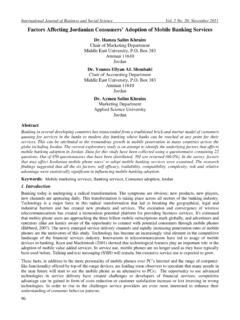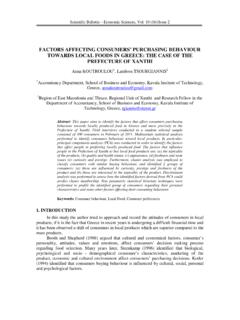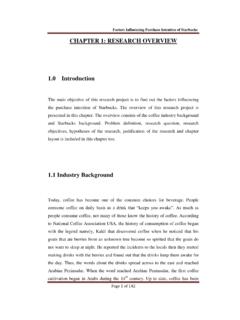Transcription of Factors Affecting Consumer Preference of International ...
1 Factors Affecting Consumer Preference of International Brands over Local Brands Zeenat Ismail1 , Sarah Masood2 and Zainab Mehmood Tawab2 1 Department of Social Sciences, Institute of Business Administration Karachi 2 Students of Institute of Business Administration Karachi Abstract: This study was conducted in order to determine the Consumer preferences of global brands instead of local ones. It is also designed to find out the buying behavior patterns of young Pakistani consumers Consumer evaluates products based on information cues, which are intrinsic and extrinsic. A number of Factors affect the Consumer purchase decisions. The results suggest that most important Factors that influence a Consumer s final decision are the price and quality of the product in question. Since the consumers usually associate the price of the brand with its quality, a brand priced too low is generally perceived as a low quality product.
2 Similarly, a product priced too high may not be affordable by many. Other Factors that have an impact on the Consumer preferences are: Consumer ethnocentrism, country of origin, social status, price relativity with the competing brands and family and friends. The research was conducted in Karachi and the samples selected included 200 people of age 16-24. The data collected for the research was through a questionnaire and was conducted in two popular shopping malls of the city and two universities since the target audience was largely the youth. Calculations were then analyzed and interpreted using a percentage of respondents and through frequency distribution tables and charts. Keywords: Consumer Preference , International brands, Local brands 1. Introduction Globalization is an inevitable phenomenon that is leading the entire world towards becoming one market, a global village. Not only has the process of globalization aided immensely in the exchange of goods and services, information and knowledge through the reductions in International barriers, but it has also led the world into becoming a real single universal community comprising of people from different cultures, thus resulting in the shrinkage of the world.
3 With the world becoming a single market, globalization has had a major contribution in enabling the organizations worldwide to step out of the restricted domestic markets and to set up their operations across the globe with confidence. This has largely led to a decline in the importance in national borders and a greater emphasis on what the consumers actually demand; be the consumers located in the very country in which the organization exists or an entirely different part of the world. Moreover, with the rapid increase in global competition, companies that strictly adhere to and cater to the needs of the local markets are finding themselves at a disadvantage and gradually loosing the competitive advantage that they so much strived to achieve. However, for some products and services "the tastes and preferences of consumers in different nations are beginning to converge on some global norm" (Holt 2002). From a Consumer perspective, however, reactions to the prevalence of global brands seem to vary among the different customers.
4 On the one hand, consumers seem to value and admire global brands and regard such brands as a status symbol. On the other hand, global brands are often criticized for threatening the local differences and imposing the western cultures on our society, leading to a loss of cultural identity. 2. Purpose of the study: Email: Tel #:+92(333) 3775545 Fax #:+92(21) 38103008 542012 2nd International Conference on Social Science and HumanityIPEDR (2012) (2012)IACSIT Press, SingaporeThis study is aimed at determining Consumer Preference of the youth of International brands instead of national or local brands in Pakistan. There are various Factors which influence Consumer purchase decision. Such as Country of origin, price of the brand fashion, family and friends, brand name, availability, advertising campaigns, consumers ethnocentrism etc. The study is also designed to find out the buying behaviour patterns of the young Pakistani consumers, attitudes towards global and local brands and the Preference for foreign brands.
5 3. Literature review Brands have been constantly reviewed and redefined in the marketing literature and there are numerous definitions for brand . A definition of a brand by The American Marketing Association (AMA) in the 1960s (Keller, 1998:2) is a name, term, sign, symbol, or design, or a combination of them, intended to identify the goods and services of one seller or group of sellers and differentiate them from those of competitors. For consumers, when deciding between brands which are in the marketplace will include brands as an element to determine the qualities of the product rather than employing their time to enhance their knowledge of the product in information searching activities. Therefore, consumers use brands as cues to make decisions to purchase or try products (Ger et al., 1993). 4. Quality Perceived quality is defined as the consumers judgment about an entity s (service s) overall excellence or superiority (Zeithaml, 1988 and Rowley, 1998).
6 Research also indicates that consumers value global brands especially for their assumed high quality and prestigious image ( , Nguyen, Barrett and Miller 2005; Steenkamp, Batra and Alden 2003). An internationally well-established brand name can act as a "halo" constructs that effects quality beliefs (Han 1989). If a brand is perceived as globally available, consumers are likely to attribute a superior quality to the brand, since such quality is thought of as a prerequisite for International acceptance. 5. Country of origin The country of origin effect has been defined as the positive and negative influence that a product s country of manufacture may have on consumers decision making processes or subsequent behavior (Elliott and Cameron, 1994). 1991). Infact in the words of Nagashima (1970), COE can be defined as the picture, the reputation, and the stereotype that businessmen and consumers attach to products or brands of a specific country.
7 This image is created by such variables as representative products, national characteristics, economic and political background, history, and traditions . The literature on country-of-origin effects is quite rich and covers the topic from different perspectives in different countries. Some studies have shown that country of origin also has symbolic and emotional meaning to consumes, and it plays an important role along with other attributes such as quality and reliability in shaping consumers attitudes toward products. Moreover, attitudes and perceptions of consumers toward brands and products will depend on categories, for instance, electronic goods from Italy may be perceived as a poor quality but Italian clothing would be perceive as fashionable and high quality (Bikey and Nes, 1982). This would be differently perceived with Japanese brands as Japanese electronic goods would be perceive with positive attitudes and Japanese clothing will be negatively perceived.
8 6. Price Researchers found out that once consumers perceive a price difference between local-owned and foreign-owned brands, price dissimilarities begin to affect their Preference for local-owned brands. Therefore, since price is also one of the most important extrinsic cues that consumers use when evaluating the product/brand (Hansen, 2005), we test the impact of price against Consumer s ethnocentric tendencies to determine at what point consumers are willing to forsake Preference for local products for a greater price discount with foreignowned products. 7. Social status 55 Authors have stressed that consumers may prefer global brands because of associations of higher prestige (Schuiling & Kapferer, 2004; Shocker, Srivastava, & Rueckert, 1994; Steenkamp, et. al., 2003). Global brands may have a higher prestige than local brands due to their relative scarcity and higher price. Furthermore, global brands may also stand for cosmopolitanism.
9 Some consumers prefer global brands because they enhance their selfimage as being cosmopolitan, sophisticated, and modern. Conversely, according to Ger (1999), local brands tend to be targeted and positioned based on a deep cultural understanding and therefore create a sustainable unique value and offer the symbolism of authenticity and prestige . Still, consumers have been found to have no intrinsic Preference for global brands (De Mooij, 1998). 8. Friends and family Reference groups include groups or people whom one can look up for guidance and ask for opinion. These are important source of influencing the brand purchases. Reference group include friends and family who influence ones buying decisions due to special skills, knowledge, personality. If a friend had a bad experience with a product, it is more likely that one will refrain from buying it. However many studies found out that, knowledge that consumers obtain through direct personal experience will be perceived to be more trustworthy than information from other communications.
10 This results in more strongly held beliefs (Swaminathan et al., 2001). 9. Research Questions y The reasons for Consumer Preference of global brands over the local ones. y The product attributes that are mostly considered by consumers when buying a brand. y The demographic characteristic of consumers who buy foreign brands more frequently. 10. Research methodology This study is a descriptive study and more of a qualitative nature and was conducted to identify and analyze the reasons why consumers prefer International brands to national brands when purchasing Consumer goods. The sample for this research included the 200 consumers whose ages ranged from 16-24 years from Karachi. Simple random sampling was used for this study. Questionnaires were used to collect primary data. The questionnaire included closed ended questions and Likert scale is used in most of the questions. These questionnaires were distributed to collect data from the students of Institute of Business Administration itself as well as the students of Institute of Business Management.


